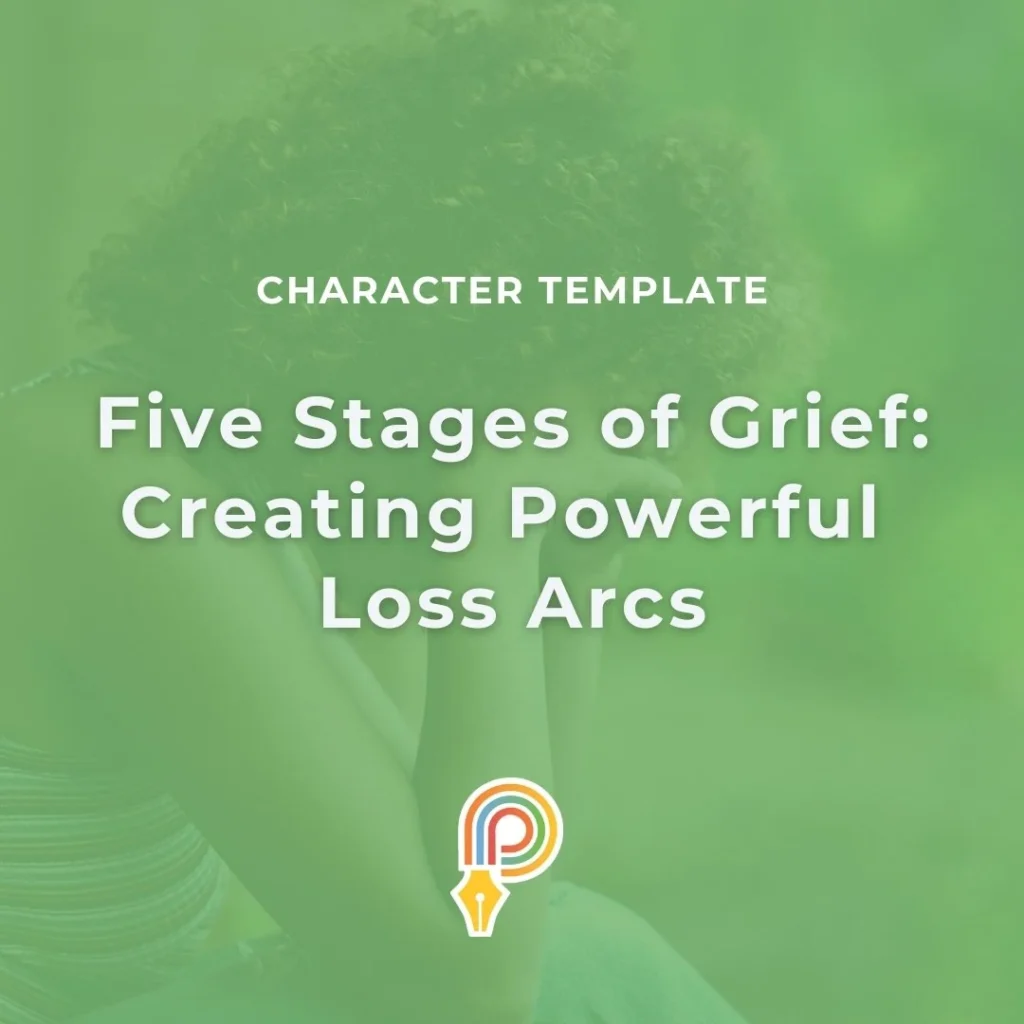You may have heard about the five stages of grief in everyday conversation, but what does it actually mean? And how can it help you create grief that feels real and moves readers?
In this article, you’ll learn how the five stages of grief help you add emotional realism to stories. Discover how to plan your characters’ arcs which involve loss using Plottr’s template.
What Are the Five Stages of Grief?
In her 1969 book, On Death and Dying, psychologist Elisabeth Kübler-Ross describes the five stages of grief. Kübler-Ross describes how people typically perceive and process loss, based on her observations of terminally ill and dying patients,
The model defines the emotional cycle we go through when we experience loss or trauma. Beginning with denial and ending with acceptance, the stages’ durations vary. An individual may move backward or forward on the path to acceptance, depending on personal experience.
Applying the five stages of grief to character development is a thoughtful way to bring realism into your stories. It also will help you earn deeper emotional engagement in readers.
In Plottr, you can use the Five Stages of Grief Character Template to plan a character’s grief cycle. Keep reading for a detailed breakdown of each stage and its typical features.
How Can Writers Use the Five Stages of Grief in Fiction?
Death happens in fiction. Not in every piece of fiction, of course. Yet it features often enough that portraying grief realistically is a useful skill to develop.
The stages of grief have many uses, not only in depicting death and its aftermath. You might choose this template to plan a retrenched or divorced character’s arc as they come to terms with painful life changes, for example.
Consider incorporating any cultural ceremonies for dealing with grief, too. For example, sitting shiva if your character is Jewish, or holding a celebration of life. (For example, your character and their siblings might hold a yearly memorial to keep their memories of a deceased parent alive.)
Grief cycles can be caused by many life-changing events. Besides the end of a marriage, giving up on a dream is another kind of major loss. Grief is the process of working through any kind of significant loss, so the stages of grief have many uses.
If you’re working in any of the following genres, consider using the five stages of grief to strengthen characterization:
- Tragic contemporary or historical fiction: tragedy often involves both grief and character development
- Fantasy: often fantasy stories involve the death of a major character (especially if you’re George R.R. Martin!)
- Dramas: those that center on the impacts of trauma
Using the five stages of grief as a framework isn’t going to box your story into a rigid form. On the contrary: stories featuring grief are often also about rebirth. As a character accepts death or other loss, they may find inner peace or new resolve.
Introducing the Five Stages of Grief Character Template in Plottr
In Plottr, you’ll see this template broken down into each of the five stages — with room for you to add context around how your characters experience and manage their grief cycles.
Here’s a deeper look at what each stage of grief represents:
Denial
In the Scrubs episode “My Screw Up,” (Season 3 episode 14), a popular recurring character, Ben, passes away. One of his best friends, Dr. Cox, is in denial regarding Ben’s death. Dr. Cox talks to the late Ben and laughs at his jokes, while no one else in the hospital can see or hear him.
Up until the last few minutes of the episode, Dr. Cox believes Ben is coming to his son Jack’s birthday party, only accepting that Ben’s dead when J.D., the main character, asks him, “Where do you think you are?” as they stand in the cemetery where Ben is interred.
Although this scenario is mostly played for humor, it also shows how deeply grief can affect a person. During denial, the bereaved may act out of character or pretend everything’s fine because they can’t deal with a loved one’s death.
Anger
In the same Scrubs episode, Dr. Cox blames J.D. for letting Ben die and in his anger, sends J.D. home from the hospital. He then works for 60 hours straight, as if subconsciously he also blames himself for Ben’s death, as he had been off-duty when Ben had a fatal heart attack.
Lashing out and blaming others (or oneself) are common expressions of anger caused by grief.
Bargaining
In grief’s context, bargaining means “struggling to accept that there’s nothing we can do to change things.” Bargaining can appear in the form of prayers to return what was lost, or acts that derive from magical thinking (like in the example below).
For example, we learn in the opening sequence of Disney’s Lilo and Stitch that Lilo gives a fish a peanut butter sandwich every day (like a sort of bribe) because she believes this fish controls the weather. Lilo’s action stems from the fact her parents died in a car accident during a storm. It suggests this is Lilo’s way of bargaining with forces beyond her control.
Depression
In W.H. Auden’s poem “Funeral Blues,” the speaker asks for the entire world to stop and observe the death of a loved person: stop all the clocks, have the police wear black gloves, stop dogs from howling, because “nothing now can ever come to any good.”
Depression caused by grief is sometimes known as “situational depression,” and is expected to fade over time. This is unlike chronic depression, which, without treatment, tends to persist regardless of circumstances.
Typical symptoms of depression include lack of pleasure in normally pleasurable activities, difficulty performing day-to-day functions, and, in extreme cases, not wanting to live.
Acceptance
At the beginning of the movie Truly Madly Deeply, the main character, Nina, is mourning the death of her husband, Jamie. Her grief is so profound that Jamie returns to her (not quite as a ghost or an angel, more as if he’d never left).
At first, Nina is delighted — they make love, they sing together — but Nina comes to realize she can’t pretend she has her old life back. When one of her friends gives birth, Nina says, “A new life” as she holds the infant, and decides to begin living her own again.
Example using the Five Stages of Grief Template in Plottr
Let’s take another look at cycles of grief using the Five Stages of Grief Template in Plottr.
We’ll use the Netflix limited series, The Haunting of Hill House. A popular fan theory is that each of the five Crain siblings represents a different stage of grief.
The audience meets each sibling in their birth order, from oldest to youngest, and their personalities cycle through the five stages from denial to acceptance.
- The eldest, Steven, represents denial: he doesn’t believe the rest of his family saw ghosts in Hill House. He can’t accept his mother is gone, even telling his father “The wrong parent died!”
- The second child and oldest daughter, Shirley, represents anger: after the death of their mother, Shirley acts as a surrogate mother to the younger siblings into adulthood. She comes to resent this position and even the choices her siblings make
- The third child, Theo, represents bargaining: she lives a consequence-free lifestyle in the belief that she won’t be hurt again if she never loves anyone
- Luke, the elder of the twins, represents depression: he takes refuge in drugs and alcohol to cope with the trauma of the ghosts of Hill House and the suicide of their mother
- Nell, the youngest and second of the twins, represents acceptance: she makes peace with their mother’s death and her own traumas from childhood and adulthood. She comforts her siblings in a speech that includes the line, “I loved you unconditionally, and you loved me just the same. The rest is confetti.”
Your character or characters don’t have to follow each of these stages in turn. Some people get caught in one stage, or skip over a stage entirely. Even so, referencing the five stages of grief will help to determine how trauma affects your characters and plot.
How to Use Plottr’s Five Stages of Grief Template
Ready to give this character template a try? It will help you plan characters’ arcs around the five stages of griefs for believable emotional progression. Here’s how:
To begin, you’ll need to purchase Plottr or sign up for a free trial.
Once you have Plottr set up on your computer, follow these five steps to add the Five Stages of Grief Template to your character:
- Step 1: To use the template, create a new project or open an existing one

- Step 2: Select the Characters tab. Create a new character, or open an existing one for editing

- Step 3: Click on +Add Template. Select Five Stages of Grief from the list of available templates, then click Choose to confirm your choice

- Step 4: Begin completing the details, browsing the included links as needed
The template will be added to your character’s profile. You can add other templates, too. As you apply the five stages of grief, you might enjoy using these:
Create Journeys Full of the Five Stages of Grief
Use this template to create emotional arcs that are rich with the tough changes that characters endure. Have you tried out the template already? Which stage is your favorite to brainstorm? Comment below! Join a free live Plottr tutorial and Q&A each Tuesday, where you can learn how to do even more with our versatile story-planning tools!







1 thought on “Five Stages of Grief: Creating Powerful Loss Arcs”
Greetings! I found this blog post to be incredibly informative and well-written. Your ability to break down complex topics into easy-to-understand language is truly a gift. Thank you for sharing your knowledge with us. I’m excited to read more of your posts in the future!